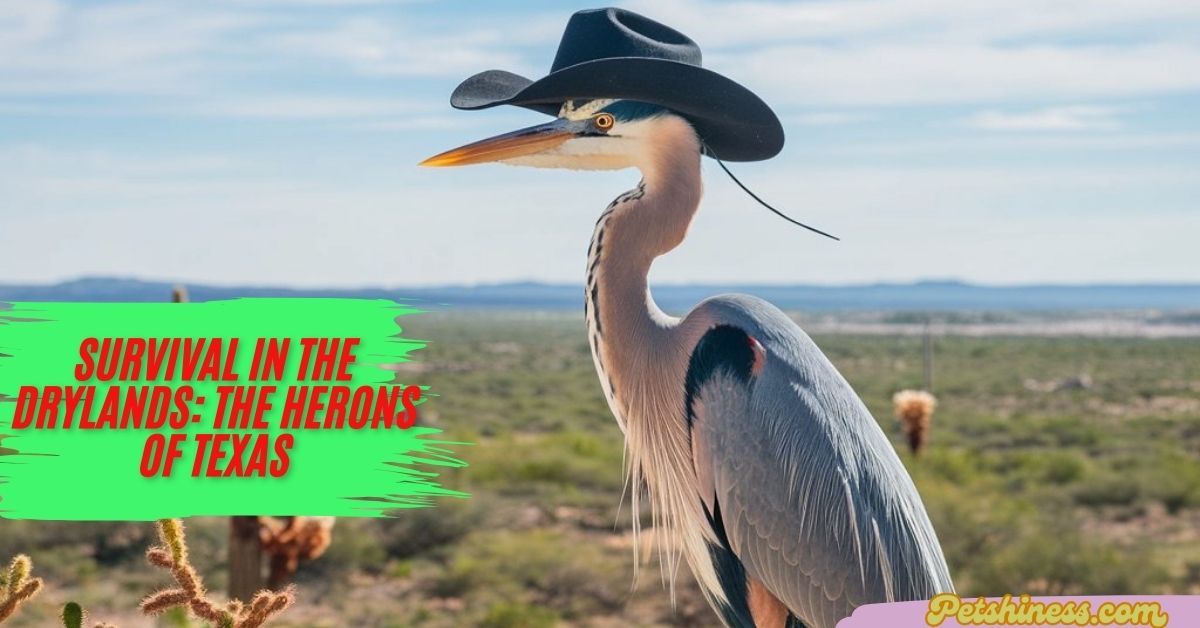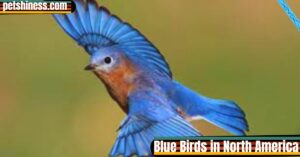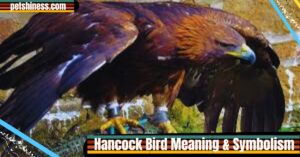Survival in the Drylands: The Herons of Texas refers to how herons manage to live in the dry, hot environment of Texas. Texas has a unique climate, with much of it being dry and arid. However, herons have adapted to survive in these challenging conditions by living near wetlands and water sources. Their ability to find food and shelter in such a dry state makes them truly remarkable.
Herons are fascinating creatures, and their survival in Texas is nothing short of amazing. In a state that faces extreme heat and drought, these birds have found ways to thrive. Their ability to hunt, nest, and adapt in tough environments makes them one of nature’s true survivors. Wouldn’t it be interesting to learn how these birds manage to live in one of the driest states?
The herons of Texas are truly special. These birds can be found along the wetlands, rivers, and coastlines of the state. They stand tall and wait patiently for their prey. Herons rely on water sources to survive, but they’ve adapted well to the dry lands of Texas. They play a vital role in the ecosystem, helping to control fish and insect populations.
Understanding Herons: What Are They?
Herons are wading birds that belong to the family Ardeidae. These birds have long necks, sharp beaks, and long legs that help them hunt for fish and small animals in shallow waters. The most common herons found in Texas are:
- Great Blue Heron
- Green Heron
- Black-Crowned Night Heron
- American Bittern
Herons are often seen standing motionless in shallow waters, waiting for the right moment to strike. Their sharp beaks allow them to capture prey like fish, amphibians, and insects.
The Texas Landscape: A Dry State with Wetland Secrets
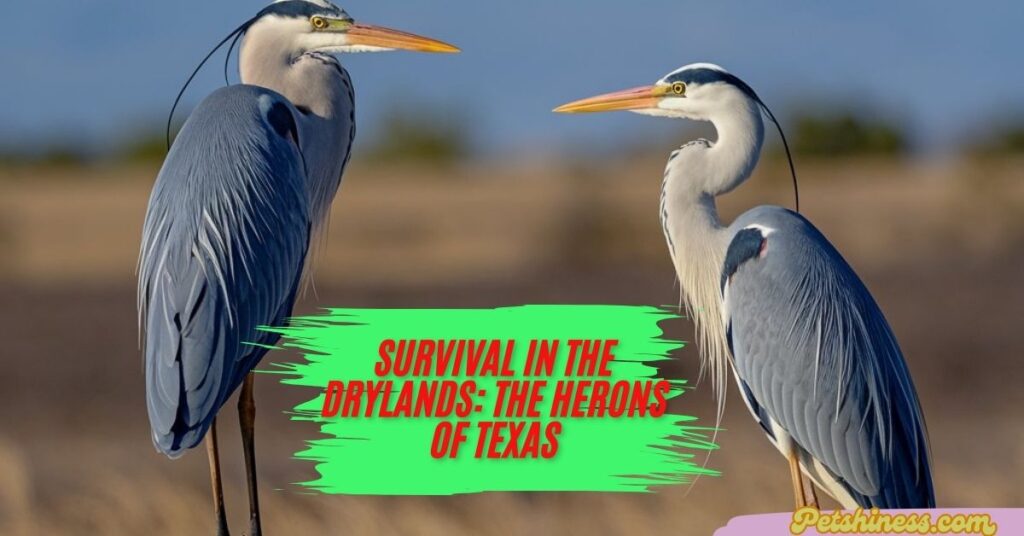
Texas is known for its diverse landscapes, deserts, forests, and prairies. While much of the state is dry, there are significant wetland areas along the coastal regions and rivers, where herons thrive. These wetlands are crucial for providing food, shelter, and nesting areas for these birds.
However, the contrast between dry lands and wet habitats makes survival more challenging. Herons must adapt to extreme heat, seasonal droughts, and limited water sources. Fortunately, wetlands provide the perfect environment for these birds to hunt and nest.
Heron Species in Texas
There are several heron species in Texas. Here’s a closer look at the most common ones:
| Species | Scientific Name | Size | Life Span | Status |
| Great Blue Heron | Ardea herodias | 36-54 inches | 15 years | Least Concern |
| Green Heron | Butorides virescens | 15-20 inches | 7 years | Least Concern |
| Black-Crowned Night Heron | Nycticorax nycticorax | 24-27 inches | 20 years | Least Concern |
| American Bittern | Botaurus lentiginosus | 23-32 inches | 6 years | Least Concern |
Each species has its unique features and behaviours. For example, the Great Blue Heron is known for its striking blue gray plumage and impressive size, while the Green Heron is smaller and elusive, with bright green feathers.
How Herons Survive in the Texas Heat
The Texas climate can be tough for any wildlife, but herons have adapted well. They can endure the high temperatures of the drylands by seeking cooler wetlands and streams. Here are some ways herons survive:
- Habitat choice: Herons tend to nest in shaded trees near water bodies, which provide them with the necessary coolness and protection from the heat.
- Feeding habits: They hunt in shallow waters, mainly for fish, frogs, and insects. Their long legs and sharp beaks are perfectly designed for wading and capturing prey.
- Behavioral adaptations: Herons rest during the hottest part of the day, reducing the risk of dehydration and exhaustion.
Despite Texas’ extreme temperatures, these adaptations help herons remain healthy and active.
- Recommended Blog : Exploring Tennessee’s Majestic Hawks: A Complete Guide
Herons as Apex Predators in Texas
Herons are considered apex predators in their habitats. Their hunting skills are unmatched. By feeding on a wide variety of fish, amphibians, and even small mammals, they help control the populations of these species. This prevents overgrowth and helps maintain the balance of ecosystems.
Here are the primary benefits herons provide to Texas:
- Control of fish populations: Herons regulate the number of smaller fish, ensuring a healthy aquatic ecosystem.
- Natural pest control: By eating insects and amphibians, they reduce the number of pests.
- Ecosystem health: Herons contribute to the overall health of wetlands by keeping species populations balanced.
Challenges Faced by Herons in the Texas Drylands
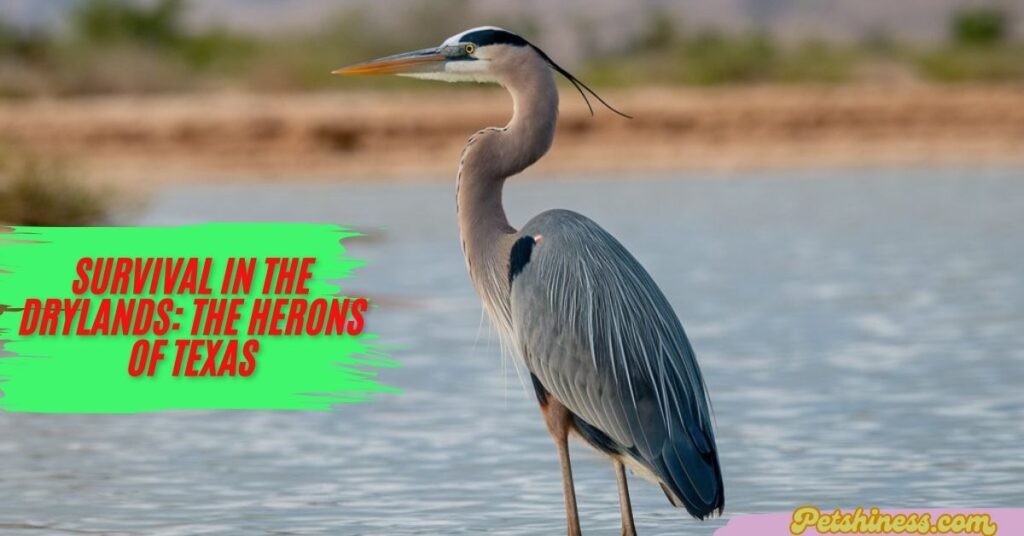
While herons are well adapted to Texas, they face a few serious challenges:
- Habitat loss: Due to urbanisation and human development, wetland areas are shrinking.
- Pollution: Pollution from nearby industries and urban areas can affect water quality, making it harder for herons to find clean water for drinking and hunting.
- Climate change: Changes in weather patterns and droughts make it harder for herons to find adequate food and water sources.
These challenges put heron populations at risk, but efforts are being made to protect their habitats.
Conservation Efforts to Protect Texas Herons
Several organisations and programs are working to protect herons and their habitats. Some of the key efforts include:
- Texas Parks and Wildlife Department: They have designated Important Bird Areas (IBAs) to protect the nesting and feeding habitats of herons and other birds.
- Coastal Bend Bays & Estuaries Program: This program focuses on the protection of coastal wetlands, ensuring herons have safe places to nest.
- Community Programs: Local communities are getting involved in wetland restoration projects and bird watching programs to raise awareness and promote conservation.
These conservation efforts help ensure that herons continue to thrive in Texas.
Best Places to See Herons in Texas
Texas has several prime spots for birdwatching, especially for herons. Here are some of the best places to spot these magnificent birds:
- Aransas National Wildlife Refuge: Located on the Texas Gulf Coast, this area is home to many heron species.
- Big Bend National Park: This park offers a combination of desert and wetland habitats where herons can be seen hunting and nesting.
- Lakes and Rivers: Many of Texas’ larger lakes and rivers, like the Brazos River, host heron populations.
When visiting these areas, be sure to bring binoculars and keep a respectful distance from the birds to avoid disturbing them.
Herons in Texas: A Symbol of Resilience
Herons are a symbol of resilience, thriving in Texas’ drylands despite facing many obstacles. They represent the strength and adaptability of wildlife in the face of a challenging environment.
Their ability to hunt, breed, and survive in Texas’ dry climate is a testament to their perseverance. It’s crucial for us to protect their habitats and ensure they have the resources they need to continue thriving in the Lone Star State.
Conclusion
The herons of Texas are not just stunning to look at, they are vital to maintaining the health of our ecosystems. Their ability to survive in the drylands speaks to their incredible adaptability and strength. But their survival is not guaranteed without our help.
We must continue supporting conservation efforts and protect the wetlands and habitats that these birds depend on. By doing so, we can ensure that future generations will be able to enjoy the beauty and importance of herons in Texas.
Frequently Asked Question
How Do Herons Survive in Texas’ Dry Environment?
Herons adapt to the dry conditions by living near water sources like wetlands and rivers, where they can hunt for food and find shelter.
What Types of Herons Can Be Found in Texas?
Texas is home to several heron species, including the Great Blue Heron, Green Heron, Black-crowned Night Heron, and American Bittern.
What Do Herons Eat in Texas?
Herons primarily feed on fish, amphibians, insects, and small mammals that they catch by wading in shallow waters.
Are Herons in Texas at Risk of Extinction?
While some heron species in Texas face threats like habitat loss, many are listed as “Least Concern” due to conservation efforts protecting their habitats.
Where Are the Best Places to See Herons in Texas?
Popular locations for spotting herons include the Texas Gulf Coast, the Rio Grande Valley, and various wetlands and marshes across the state.

Jerry John ensures petshiness.com runs smoothly and securely. With a passion for tech and a focus on user experience, Jerry manages the site to deliver top-notch content and functionality.
